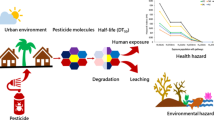Abstract
The degradative kinetics of pesticides on plant surface are characterized by an initial rapid degradation which follows a first-order kinetics, then transferred to a more slower degradative rate. The degradative process mainly consists of photodegradation, evaporation, rainfall elution and growth dilution. The influencing parameters of these processes were investigated by using the tea plant as a case study. The predictive model of the initial concentration, photodegradation rate constant, evaporation rate constant, rainfall elution rate, growth dilution rate and the total degradation rate was discussed and verified in four locations situated in the range of 25°-30°N latitude, and acceptable results were obtained.
Similar content being viewed by others
References
Bentson, K.P.:1990, Rev. Environ. Cont. & Toxicol. 114, 125–161.
Benner, P.: 1972, Approximate values of intensity of natural ultraviolet radiation for different amounts of atmospheric ozone, US Army Report DAJA 37-68-C-C-1017, Davos Platz, Swotzerland.
Chen, Z.M.:1983, Sci. Agricul. Sinica. 16(1)62–70.
Chen, Z.M.:1984, J. Tea Sci. 4(1)9–18.
Chen, Z.M. & Wan, H.B.:1988, Pesti. Sci. 23,109–118
Chen, Z.M.: 1990, In “Proceedings of the International Seminar of “Recent Develoment in the Field of Pesticides & their Application to Pest Control” ed by K. Holly et al, held at Shenyang, China, Oct. 8–12.
Chen, Z.M.: 1992, Proceed. of XIX International Congress of Entomology (Abstracts) P564.
Chen, Z.M. et al: 1992, In “Advances in the Investigation on the Technology of Chemical Control” ed. by Du, Y. C., Xinjian Sci. & Technol. Press, pp 185–190
Choudry, C.G. & Webster, G.R.B.:1985, Residue Rev. 96,79–136.
Jury, W.A., Winer, A.M. et al.:1987, Rev. Environ. Contam. & Toxicol. 99,119–164.
Schulze, E.E.: 1982, In “Physiol. Plant Ecol.” Vol.2. Encyel. of Plant Physiol., Vol.12B, ed. by Lange, O.L. et al., Springer Verlay, Berlin, New York, pp615–676.
Tao, S. M. & Chen, Z.M.:1994, Acta Sci. Circum. 14(1) 64–71.
Willis, GH. & McDowell, L.L.:1987, Rev. Environ. Contam. & Toxicol. 100,23–73.
Xia, H.L. & Chen, Z.M.: 1989, J.Tea Sci., 9(2)133–139.
Xia, H.L. & Chen, Z.M.: 1992, J.Tea Sci., 12(1)1–6.
Xue, Y.Z. & Chen, Z.M.: 1992, In “Advances in the Investigation on the Technology of Chemical Control”, ed. by Du, Y.C., Xinjian Sci. & Technol. Press, pp 165–170.
Chen, Z.M.: 1983, Sci. Agric. Sinica. 16(1)62–70.
Author information
Authors and Affiliations
Rights and permissions
About this article
Cite this article
Zongmao, C., Haibin, W. Degradation of Pesticides on Plant Surfaces and its Prediction - A Case Study on Tea Plant. Environ Monit Assess 44, 303–313 (1997). https://doi.org/10.1023/A:1005791514357
Issue Date:
DOI: https://doi.org/10.1023/A:1005791514357




